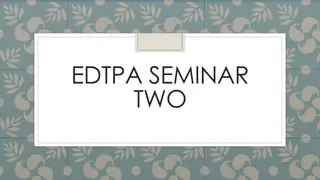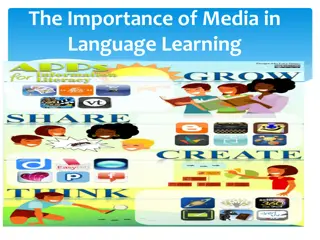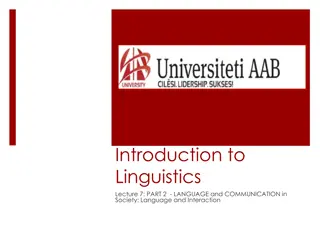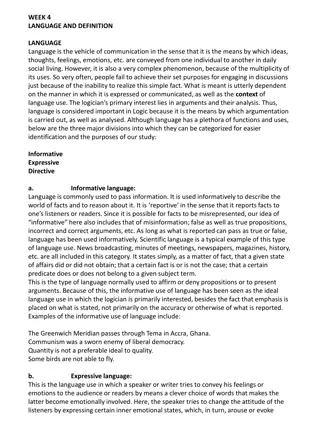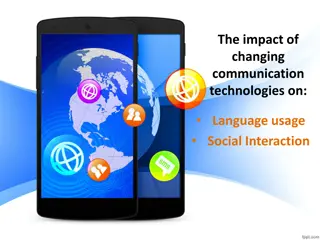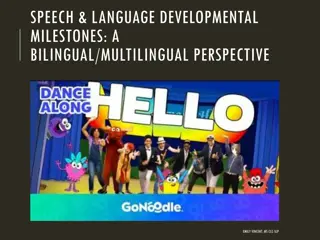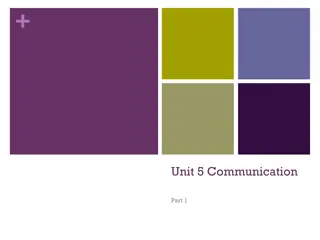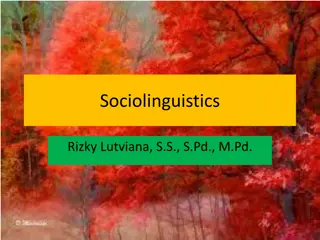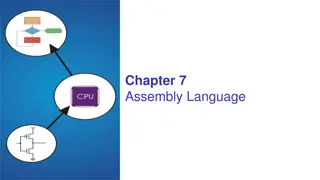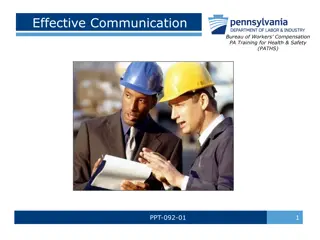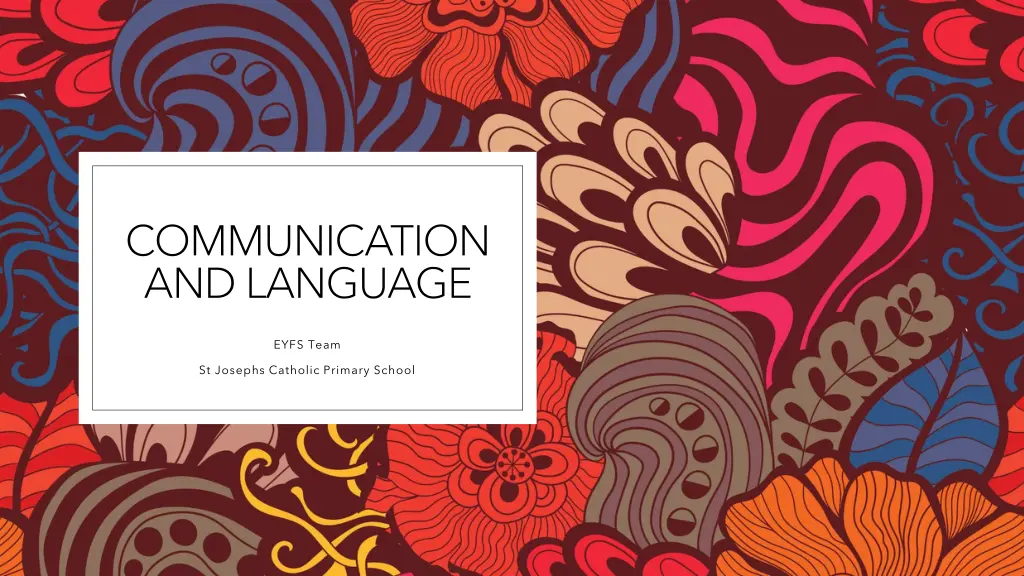
Effective Communication Skills for Children | St. Joseph's School Program
Discover the importance of communication skills in children's development through the program offered by St. Joseph's Catholic Primary School. Learn about listening, interaction, play, and understanding as crucial elements for effective communication. Enhance your child's vocabulary and language abilities gradually to set them up for success in education and life.
Download Presentation

Please find below an Image/Link to download the presentation.
The content on the website is provided AS IS for your information and personal use only. It may not be sold, licensed, or shared on other websites without obtaining consent from the author. If you encounter any issues during the download, it is possible that the publisher has removed the file from their server.
You are allowed to download the files provided on this website for personal or commercial use, subject to the condition that they are used lawfully. All files are the property of their respective owners.
The content on the website is provided AS IS for your information and personal use only. It may not be sold, licensed, or shared on other websites without obtaining consent from the author.
E N D
Presentation Transcript
COMMUNICATION AND LANGUAGE EYFS Team St Josephs Catholic Primary School
What do you think communication means?
Being able to communicate is not just about talking. Getting your own message across Expressing your feelings appropriately Being able to listen Paying attention Interacting and playing with others Understanding what is being said These are all fundamental skills a good communicator needs. This presentation explorers these important skills and contains lots of ideas and activities to help you support your child with their development.
You dont run a marathon You don t run a marathon to run a marathon Build up slowly to get ready and prepare for the marathon. to run a marathon Research shows that Research shows that vocabulary size has a vocabulary size has a huge impact on how huge impact on how well children will well children will perform in education perform in education and their life and their life chances. Children chances. Children with a limited with a limited vocabulary at the vocabulary at the end of EYFS are end of EYFS are twice as likely to be twice as likely to be unemployed at 34. unemployed at 34. Same with education it is a gradual build up marathon is run in primary school at the end of Year 6. Start of this is developing children s language and communication in EYFS. Don t restrict or limit the language you use Don t restrict or limit the language you use give them difficult stuff e.g. tea bag in a cup of water them difficult stuff e.g. tea bag in a cup of water infuses . infuses . give
Our approach Share attention Respond Expand Conversation https://youtu.be/HJSfZRtUM Xk
Four Areas of Effective Communication Listening Interaction Play Understanding
Listening is an essential skill for talking and learning. Everywhere we go there are different noises around us. Listening Sometimes children need a bit of quiet time to help them tune into talking rather than the other noises going on around them. Listening is different to hearing. Adults need to show children the way when we listen to children, they learn what to do in order to be good listeners. Be a Listening Role Model what does this look like?
Play listening games Matching sound games are fun there are lots of commercial ones you can buy but you can make up your own. Collect a number of pots and pans. Allow your child to test them out and then ask them to shut their eyes while you strike one. Can they identify which one? You can also play the same game with pictures of animals. Make a noise and ask them which animal made the noise. Developing Listening Following instructions This can be great when you have lots of housework to do! Can you go and get me the laundry basket? Build up the number of instructions until you get to at least 3. Can you put your shoes away, hang up your coat and put the water bottle in the sink please?
Rhyme and Repetition Read lots of stories with rhyme and repetition The Great Big List of 55 Rhyming Picture Books for Kids (childhood101.com) Developing Listening Give clues about different things that rhyme there might be more than one right answer. It s a part of your body, it rhymes with bed. It s something you ride in, it rhymes with throat. It s an animal, it rhymes with peep. It s an insect, it rhymes with wider. Show Me / Tell me Tell a story about something that involves steps to complete a task e.g. dressing up you have to listen and remember exactly what is worn. I am going to wear my big red shoes, purple spotty trousers, a yellow shirt and a red bow tie and on my head a green hat with a feather on top. Show Me / Tell Me What am I wearing?
We communicate and interact with each other in different ways; learning the skills of interaction is really important for having good conversations and interactions with others. We need to learn: Interaction When to talk and when to listen. How to take turns. How to notice if someone is not listening or bored with what we re saying. We need words to do this, but also skills in looking, listening and noticing people around us. Children learn from adults by watching how they interact with other adults and with children. Be an Interaction Role Model what does this look like?
What is different? Get your child to look at you carefully and then ask them to close their eyes. While they are not looking, change something about your appearance, like rolling up your sleeves, messing up your hair or putting on some glasses. Can they spot what is different? Developing Interaction Favourite Things Game Play a game sharing ideas of favourite things. Ask your child what their favourites are and tell them yours. My favourite food is bananas-modelling intonation and how to say a question sense of a sentence . Model then ask the child to copy My favourite day is... My favourite book is... My favourite sport is...
Three Good Things Share some time with your child to talk about what they have enjoyed in their day. A good way to do this is to start by sharing with them good things that have happened in your day. Then ask, Can you think of three good things you did today? What made you happy today? Developing Interaction Charades Get your child to play charades. Write down the words and phrases below on separate pieces of paper. Your child chooses one and acts it out for you to guess. Film - The Lion King Book - Frog on a Log I went to Market Each player has to say what they brought and what everyone else did too! I went to market and I brought an apple. I went to market and I bought an apple and an book etc.
Understanding is key to talking and learning. Understanding Children need to understand what single words mean and when words are joined together into sentences, conversations and stories. Children go through phases where they ask lots of questions. They are trying to find out how things work and understand the world around them. Adults play an important role in answering the many questions children have and in checking out whether children understand and modelling how to pose questions and what we do if we don t know the answer. Understanding help us to: Keep us safe Be informed Work out what is happening in a situation Continue learning/moving forwards Appreciate others feelings and express our own needs appropriately
Riddles Tell riddles and see if your child can guess the answer: It s an animal, it has stripes, it s black and white... It s a food, it s round, it s crunchy, it grows on trees, it begins with a Developing understanding Sentence Starters You begin a sentence and someone else finishes it. Decide whether it s silly or sensible: Chicken is my favourite... One day I ate an enormous... In my garden I saw a... I won an amazing... The clown I saw was juggling... Odd one out Which is the odd one out of the following: Sheep, cow, chicken, lion Apple, orange, grapes, carrot Chair, table, sofa, hat Cabbage, yoghurt, potato, broccoli Football, rugby, judo, cricket
Play Play is a really important part of children s learning and development. Children learn all kinds of skills through play; they learn how things work, how to interact and share with other children, how to play with different toys and to enter a world of imagination. Playing enables children to test things out in a safe way, to learn about emotions and to talk with others. Children often love adults to play with them. It s great if you can follow their lead and join in the fun. Be a Play Role Model what does this look like?
Board games Dobble Kim s Game Spot the difference Developing play Construction and Small World Construction and small world also offers the opportunity for children to build on their language skills, expanding their vocabulary and their understanding. Physical Gross Motor Play Active play in children is required for brain growth, physical development, communication and social growth. The Best Role Models Play with or alongside Children
Developing talk Would anybody like to share their ideas or tips for developing talk?
Finally Education is the process of preparing us for the big world, and the big world has big words. The more big words I know, the better I will survive in it. Because there are hundreds of thousands of big words in English, I cannot learn them all. But this doesn t mean that I shouldn t try to learn some. (Word, words, words, by David Crystal)


